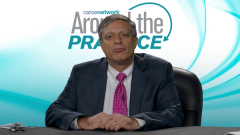
R/R MM: Optimizing Treatment Sequencing With Bispecific Antibodies
Before closing out their discussion on bispecific antibodies in relapsed/refractory multiple myeloma, key opinion leaders consider optimal sequencing of these agents.
Episodes in this series

Transcript:
Caitlin Costello, MD: We’ve seen that our lymphoma colleagues do prophylactic corticoid steroids. Many of these bispecifics already engage that as an option and already do that. Maybe that’s something we need to think about a little more aggressively. With all these great bispecifics, how we sequence them? What do we do? As it stands, many of us are going to BCMA as our targeted interest first. What are we going to go swap between bispecifics and target by target? Or are we going to try to find something to intermix so we can allow those exhausted T cells to regenerate a little. How are we going to do this? What great options. What a great problem.
Samuel M. Rubinstein, MD: It’s a first-world problem.
Sandy Wong, MD: One of the biggest questions is if you can do T-cell engager after T-cell engager after T-cell engager. Wouldn’t the T cells be so exhausted that it won’t work if you follow it with another T-cell engager? It was exciting to see that with the GPRC5D T-cell engagers, you can use that after a BCMA T-cell engager. It was decent in terms of response rate. If you squint, maybe it was slightly lower than your usual 60% to 70%; it was like 50%. That’s not shabby. I was heartened to see that you can follow 1 after the other. Maybe it’s possible. Then you can do a BCMA, then GPRC5D, and then FCRH5.
Timothy Schmidt, MD: Even BCMA followed by BCMA is a viable option in many circumstances. After CAR [chimeric antigen receptor] T-cell failures and the use of BCMA bispecifics, you’re still seeing decent response rates in patients who have access to it. Of course, we can get into the weeds about T-cell exhaustion and how much that impacts the efficacy of our treatments. We need to figure out how best to do this so that we optimize the use of such great therapies. Ultimately, we’re going to go to what we have access to. We’re going to go with the best option at that point in time. The fortunate thing is that these are all there now. They’re all coming. A wealth of new drugs are going to be available for us in the late-relapse setting.
Caitlin Costello, MD: We finally have real-world data to help guide us. That’s what it’s going to come down to, because questions come up. Do we need a little washout? Are we going to adequately apheresis T cells if patients have been on bispecifics just prior? We’re trying to look for a CAR T. Lots of questions are emerging. We’re finally seeing trials including BCMA-exposed patients. We can start getting some of those answers. CAR-T consortia are offering us real-world data that we can look at retrospectively to understand what’s happening.
Sandy Wong, MD: Some data are starting to emerge about what might happen. For example, the CARTITUDE-2 study cohort C was presented at IMS [International Myeloma Society Annual Meeting]. They allowed patients with prior BCMA-directed treatment who then got cilta-cel [ciltacabtagene autoleucel]. I was surprised that the response rate dropped by half. As a monotherapy in the registration study, it was 97%, but it went down to 50%. That’s real. These are early days, and that’s just 1 study. But it makes me wonder that it may not necessarily be the best idea. However, in reverse, it might be OK. We saw some data with teclistamab that if you have prior BCMA-directed CAR and then come in with teclistamab, the response rate didn’t drop that much—maybe by 10 percentage points, but not significantly. Not like the other way around. These are early days, but we’re starting to see some clues in terms of how we can sequence therapies.
Sagar Lonial, MD: The mechanism of resistance in somebody who relapses on a BCMA-directed CAR in 1 year or beyond is probably different from somebody who progresses on a T-cell engager with constant pressure on the clone. Binding is going to be an issue. Genetics and clonal evolution are going to be issues. How you define BCMA resistance is a real challenge in 2022.
Transcript edited for clarity.
Newsletter
Stay up to date on recent advances in the multidisciplinary approach to cancer.


































































































